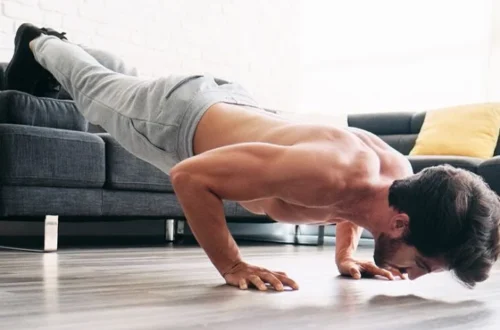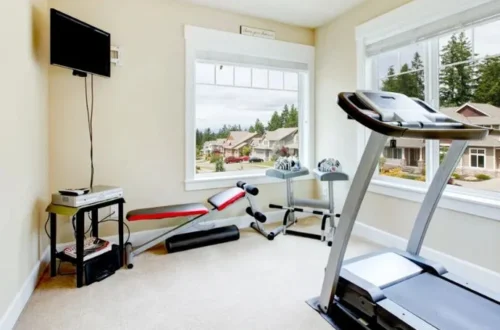Three months ago, I stood in my small living room and looked at the couch where I had spent too many nights binge-watching Netflix. I had been wanting to get back in shape for months, but with job, family, and life in general, it seemed difficult to find time to go to the gym. That’s when I learned something that changed everything: you can work out your whole body without ever leaving your house.
If you’re tired of making excuses about not having time for the gym or feeling intimidated by intricate fitness equipment, this guide is for you. I’ll tell you what I learned about how to make a good at-home workout plan that works all of your muscles and fits into even the busiest schedule.
By the end of this piece, you’ll have a full plan for how to make your own total body workout regimen, and you’ll feel ready to start your fitness adventure right in your living room.

Why Full-Body Workouts Are Perfect for Beginners
There are so many ways to work out at home that I was bewildered at first. Should I work out the same muscle groups every day? How many times do I need to work out? That’s when I learnt how amazing a full-body workout can be.
Time Efficiency That Actually Works
A full-body workout works out all the major muscle groups in one go. You can still obtain great results with just 30 to 45 minutes of exercise three times a week. This efficiency made a big difference for someone who had to balance work and family.
Perfect for Building a Foundation
I started with workouts that worked my whole body to build up my strength and coordination before moving on to more specific routines. You’ll get stronger in a way that helps you do everyday things like carry groceries or play with your kids.
Maximum Results, Minimum Time
Studies demonstrate that full-body workouts can help you build muscle and lose fat just as well as split regimens, especially for people who are new to working out. You’ll encourage muscular growth across your entire body while burning calories long after your activity ends.
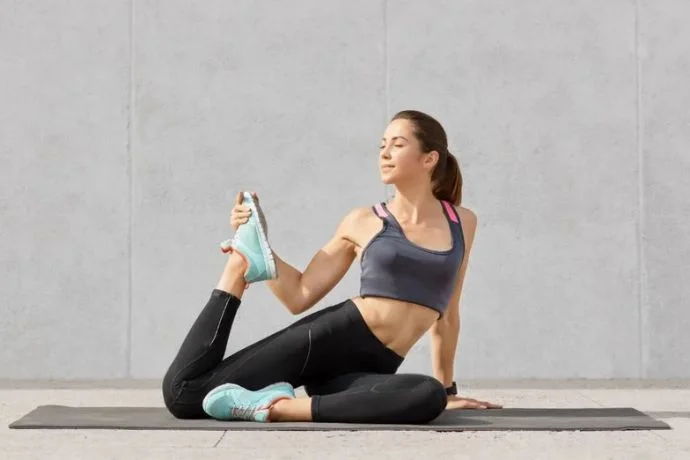
Essential Equipment for Your Home Full-Body Workout
The nicest thing about working out at home is that you don’t need to buy pricey equipment to get started. I started with just my own weight and then added a few simple tools as I got better.
Start With Zero Equipment
You can do bodyweight exercises for your first full-body workout. Push-ups, squats, lunges, and planks are all great ways to work out all of your muscles. I worked out for the first month without any equipment and experienced big increases in my strength and endurance.
Budget-Friendly Additions (Under $50)
These easy-to-use tools will provide you with more alternatives for exercises if you’re ready to move on:
Resistance Bands ($15–20): These light bands may be used to do practically any gym workout and give different levels of resistance. I use mine for rows, chest presses, and leg workouts.
Yoga Mat ($10–15): This is a must-have for floor workouts and gives your joints some extra protection while you do planks, mountain climbers, and stretches.
Water Bottles as Weights ($0): I used to use water bottles filled with sand or water instead of dumbbells. They are great for arm workouts and making squats harder.
Nice-to-Have Equipment (Under $100)
These tools can help you get better at working out as you get better:
Adjustable Dumbbells ($40-60): Allow for progressive overload and additional exercise diversity.
Pull-up Bar ($20–30): Adds upper body pulling workouts that are challenging to do with only your body weight.
The Science Behind Effective Full-Body Training
Let’s first talk about what makes a full-body workout work before we get into the details of the exercises. With this information, I was able to make routines that worked instead of just making me fatigued.
The Big Movement Patterns
These basic movement patterns should be part of any good total body workout:
Push Movements: Use your chest, shoulders, and triceps (for example, push-ups and overhead presses).
Pull Movements: Work your back and biceps (rows, pull-ups)
Squats and lunges work your quads, glutes, and core.
Hinge Movements: Focus on your posterior chain (deadlifts, glute bridges)
Core Stability: Make your midsection stronger by doing planks and mountain climbers.
Progressive Overload at Home
Progressive overload, or gradually making things harder over time, is the secret to making things better all the time. You can do this in your home training regimen by:
- More and more repetitions
- Adding more sets
- Slowing down the speed of the movement
- Cutting down on the time between exercises
- Using bands or weights to add resistance

Creating Your Perfect Full-Body Workout Structure
I tried a lot of various regimens, but I finally found one that always works and keeps exercises fun and doable.
The Warm-Up: Don’t Skip This Step
I used to skip warm-ups and go right into exercises. Big error. A good warm-up keeps you from getting hurt and helps you do better. This is my five-minute routine:
Dynamic Movements (2-3 minutes):
- Circles with your arms (forth and backward)
- Leg swings (side to side and front to back)
- Twists of the torso
- Marching in place with light
Activation Exercises (2-3 minutes):
- Squats with your own body weight (slow and controlled)
- Push-ups against a wall
- Bridges for the glutes
- Stretches for the cat and cow
The Main Workout: Your Full-Body Foundation
A full-body workout that is well-organized should last 25 to 40 minutes and contain exercises for each type of movement. This is the template I use:
Exercise Selection:
- 1–2 pushups
- 1–2 pull-ups
- 2–3 exercises for the lower body
- 1–2 core workouts
Rep and Set Schemes:
- For beginners, do 2–3 sets of 8–12 reps.
- Take a break of 45 to 90 seconds between sets.
- Concentrate on good form instead of speed
The Cool-Down: Finish Strong
Take 5 to 10 minutes to calm down by doing some easy stretching and deep breathing. This helps your body heal and makes you less sore the next day.

Beginner Full-Body Workout Routine
Are you ready to put what you learned into action? This is the identical home training regimen I used to get started. You don’t need any equipment for this routine, and it just takes 30 minutes.
Workout A: Foundation Builder
Warm-up (5 minutes)
- Ten circles of the arms in each direction
- Leg swings: 10 swings in each direction for each leg
- Do 10 slow bodyweight squats.
- Do 10 push-ups against a wall.
Main Workout (20-25 minutes)
Push-ups (2 sets of 5-10 reps)
If you need to, start on your knees. Make sure your form is correct: your head, knees, and hands should be in a straight line, and your hands should be a little broader than your shoulders. Lower your body until your chest almost meets the floor.
Bodyweight Squats (3 sets of 10-15 reps)
Stand with your feet shoulder-width apart and lower your thighs until they are parallel to the floor. Then, push through your heels to stand. This is the basis for all workouts that work the whole body.
Glute Bridges (2 sets of 12-15 reps)
Put your feet flat on the floor and lie on your back. Squeeze your glutes and elevate your hips. At the top, hold for one second.
Plank Hold (2 sets of 15-30 seconds)
Start with the longest time you can hold with flawless form. Slowly build up.
Lunges (2 sets of 6-8 per leg)
Step forward, bend your knee in the back, then push through your front heel to get back up.
Mountain Climbers (2 sets of 10 per leg)
Begin in a plank position and carefully bring your knees to your chest one at a time.
Cool-down (5 minutes)
- Fold forward while standing
- Stretching your quads while standing
- Twist your spine when sitting
- Breathing deeply
Workout B: Building Complexity
After doing Workout A for 2–3 weeks, move on to this one:
Five minutes of warming up
Like Workout A
Main Workout (25 to 30 minutes)
Different kinds of push-ups (3 sets of 6 to 12 reps)
Start with knee push-ups, then move on to full push-ups. After that, attempt incline or decline push-ups.
Two sets of 8 to 10 single-leg glute bridges per leg
This one-sided workout is harder than ordinary bridges and helps you get stronger and more balanced.
Reverse Lunges: 3 sets of 8 to 10 on each leg
Instead of going forward, go back. This variation is easier on the knees and is perfect for people who are just starting out.
Side Plank (two sets of 10 to 20 seconds on each side)
Strengthens the sides of your core that normal planks don’t.
Wall Sit (two sets of 20 to 45 seconds)
Put your back against the wall and slide down until your thighs are level with the floor. Hold it and feel the fire.
Burpees (2 sets of 3 to 6 repetitions)
The best activity for working out your whole body. Take it easy at first and pay more attention to form than speed.
Workout C: Strength and Endurance
Try this difficult workout after 4 to 6 weeks of regular training:
Warm-up with movement (5 minutes)
Jumping jacks and high knees should be part of your normal warm-up.
30 minutes of circuit training
Repeat Circuit 1 three times, with a one-minute break between rounds:
- 30 seconds of push-ups
- 30 seconds of squats
- Plank for 30 seconds
- Take a break for 30 seconds.
Circuit 2 (Repeat 3 times):
- Lunges: 45 seconds
- Climbers on the mountain: 45 seconds
- Glute bridges: 45 seconds
- Take a break for 45 seconds.
Circuit 3 (Repeat 2 times):
- 20 seconds of burpees
- Sit against a wall for 40 seconds.
- 40 seconds of alternating side plank
- Take a break for 60 seconds.

Common Mistakes to Avoid in Your Full-Body Workout
If you learn from my early mistakes, you can save yourself weeks of frustration and avoid getting hurt.
Mistake 1: Too Much, Too Soon
I attempted advanced exercises on the first day and became so sore that I was unable to exercise for a week. Begin with simple movements and slowly make them harder. Your exercise journey at home is a long one, not a short one.
Mistake 2: Ignoring Form for Quantity
Five perfect push-ups are better than twenty sloppy ones. Concentrate on motions that are regulated and use the whole range of motion. In entire body exercises, quality is always better than quantity.
Mistake 3: Not Tracking Progress
I kept track of my exercise for the first month by memory. Write down the exercises you do, the sets and reps, and how you feel. It really helps to see progress on paper.
Mistake 4: Skipping Rest Days
I thought more was always better and worked out every day. Give your muscles time to heal and grow. Try to do three to four full-body workouts a week, with days off in between.
Mistake 5: Comparing Yourself to Others
You could feel like everyone else is in better shape than you when you use social media. Keep in mind that your only competition is the you from yesterday. Pay attention to how far you’ve come and appreciate tiny wins.
Nutrition to Fuel Your Full-Body Workouts
Exercise is only one component of the puzzle. What you eat before and after your home workout plan can have a big effect on how well you do and how quickly you recover.
Pre-Workout Nutrition (30-60 minutes before)
You don’t need to buy pricey vitamins. The best foods are entire and simple:
Light Options:
- A banana with a little almond butter on top
- Greek yogurt with fruit
- Fruit and oatmeal
Hydration:
Drink 8 to 16 ounces of water half an hour before you work out. Not drinking enough water can have a big effect on your performance and make your full-body workout feel much harder.
Post-Workout Recovery (within 30 minutes)
Your body requires protein to fix muscles and carbs to provide you with energy:
Quick Options:
- Banana and spinach protein smoothie
- Chocolate milk (which works surprisingly well for recuperation)
- Granola with Greek yogurt
Daily Nutrition Habits
Daily dietary practices that are consistent are more important than exact timing before and after workouts:
- Eat protein with every meal to support muscle recovery
- Stay hydrated throughout the day
- Include plenty of vegetables for vitamins and minerals
- Don’t drastically cut calories while starting a new exercise routine
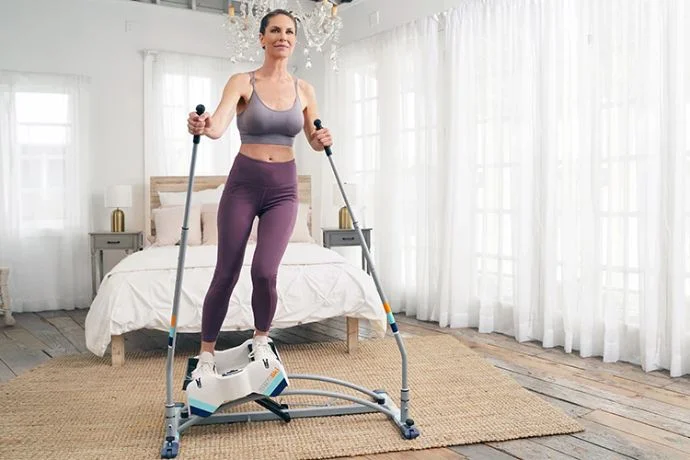
Adapting Your Routine as You Progress
As you get stronger, your program of exercises for your whole body should change. Here’s how to move forward in a planned way:
Weeks 1-2: Master the Basics
Concentrate only on learning the right way to do the exercises and making them a habit. Don’t worry about how hard it is or how advanced the variations are yet.
Goals:
- Do 2 to 3 workouts a week.
- Learn how to do all the basic movements correctly.
- Make a routine and stick to it.
Weeks 3-6: Increase Volume and Intensity
Once you’ve gotten the hang of the fundamental moves, make them harder little by little:
Progression Methods:
- Every week, add one or two extra sets of repetitions.
- For each exercise, go from 2 to 3 sets.
- Cut the duration between workouts by 10 to 15 seconds.
Weeks 7-12: Add Complexity and Variety
To keep your body challenged, try various activities and ways of training:
New Challenges:
- Changes that only affect one limb, such as one-arm push-ups and single-leg squats
- Jump squats and clap push-ups are examples of plyometric exercises.
- Supersets and circuit training
- Tempo changes and isometric holds
Month 4 and Beyond: Specialize Your Goals
Once you have a strong base, you can set particular goals:
Strength Focus: Use weights or bands to make it harder, and focus on gradual overload.
Stamina Focus: more reps, shorter breaks, and circuit training
Being flexible Focus: Include longer stretching sessions and yoga flows
Sport-Specific: Add movements that help you do the things you like to do.

Staying Motivated for Long-Term Success
The hardest aspect of any home workout regimen isn’t the exercises; it’s sticking with it over time. These are the things that helped me stick with it:
Set Process Goals, Not Just Outcome Goals
Instead of focusing only on losing 20 pounds, set goals like:
- This week, do three full-body workouts.
- Do 10 push-ups perfectly without stopping.
- For one month, work out every day.
You have complete control over your process goals, and reaching them gives you confidence.
Create a Reward System
Give yourself rewards that aren’t food to celebrate your progress:
- New workout clothes after sticking to it for a month
- A massage after reaching a strength goal
- When you’ve outgrown bodyweight exercises, it’s time to get a new piece of equipment.
Find Accountability
Tell your friends, family, or people in online forums about your ambitions. On days when things are hard, taking pictures of your progress, writing about your exercises, or finding a virtual fitness companion can help you stay motivated.
Track Everything
Keep a journal of your workouts with:
- Exercises done
- Sets and repetitions finished
- How you felt during the exercise
- Any changes made
- Pictures of progress per month
It’s quite motivating to see how much better you’re getting over time, which helps you stick to your home fitness regimen.

Building Your Home Workout Environment
Making a special area for your full-body training might help you stay on track and do better.
Designating Your Space
You don’t need a whole room; only 6 feet x 6 feet of open area will do. I move the coffee table out of the way in my living room for 30 minutes. The most important thing is to make it as easy as possible to begin your workout.
Minimizing Distractions
Managing your phone: Turn on airplane mode or utilize a special exercise playlist. You can wait 30 minutes to use social media.
Family Time: Let your family know when you plan to work out. Think about working out in the morning or when the kids are watching TV.
Environmental Cues: The night before, put out your workout clothes and gear. Visual signals help you follow through on what you want to do.
Creating the Right Atmosphere
Music: Make playlists that get you pumped up and fit the intensity of your workout. Music that makes you feel good can help you do better by up to 15%.
Temperature: Make sure your workout area is cool. When you do total body exercises, you’ll get hot quickly; therefore, it’s important to stay cool to keep up your performance.
Lighting: Good lighting makes you feel better and gives you more energy. The best light is natural, although intense artificial light works too.

Troubleshooting Common Challenges
Everyone who wants to work out at home has to deal with problems. Here’s how to get past the most prevalent ones:
Challenge: “I Don’t Have Time”
Solution: Do workouts that last 15 minutes to start. Three 15-minute sessions a week are a lot better than no 60-minute sessions at all. As the habit gets stronger, you can always make it last longer.
Time-Saving Tips:
- Do some exercise first thing in the morning.
- Put workouts together into supersets.
- Take a break from commercials to move around quickly.
- Do an exercise instead of watching one episode of TV.
Challenge: “I Get Bored Easily”
Solution: The key to sticking with something for a long time is variety. Here are some ideas for making your full-body workout more fun:
Weekly Variations:
- Change the sequence of the exercises
- Try different rep ranges, such as high reps one day and low reps the next.
- Add additional exercises every month
- Watch workout videos online every now and again.
Challenge: “I Don’t See Results Fast Enough”
Solution: Results take time, but they are happening even if you can’t see them. Focus on wins that aren’t on the scale:
Early Indicators of Progress:
- Better quality of sleep
- More energy all day long
- Things that used to be hard to do become easy.
- Better mood and stress control
- Clothes that fit differently
Challenge: “I Feel Intimidated by Exercise”
Solution: Remember that everyone starts somewhere. Even elite athletes were beginners once.
Confidence Builders:
- Start with the easiest versions of each exercise.
- Don’t compare yourself to other people; instead, think about how well you’re doing.
- Celebrate every little win
- Keep in mind that being consistent is more important than being perfect.
Sample Weekly Schedule
To get the most benefits and recovery from your home workouts, here’s how to plan them out throughout the week:
Option 1: Three Days Per Week (Beginner-Friendly)
30 minutes of full-body exercise on Monday A
Take a rest or perform some light stretching for 10 minutes on Tuesday.
Wednesday: Full-body workout B for 30 minutes
Thursday: Take a break or go for a short walk.
Full-body workout C for 30 minutes on Friday
On the weekend, do things that are good for you, like hiking, playing with kids, or doing tasks around the house.
Option 2: Four Days Per Week (Intermediate)
Full-body workout on Monday, with a focus on the upper body (25 minutes)
Tuesday: 25 minutes of training for the whole body that emphasizes the lower body
Wednesday: Do yoga or take a break.
Thursday: 30 minutes of circuit training for the complete body
On Friday, work on your core and do some cardiovascular exercise for 20 minutes.
On the weekend, you should rest for one day and do something active for the other.
Option 3: Five Days Per Week (Advanced)
Monday: A full-body exercise that focuses on strength
Tuesday: Cardio and core
Wednesday: Work on your upper body
Thursday: Work on your lower body
HIIT or a full-body circuit on Friday
One day of rest and one day of active recovery on the weekend

Advanced Techniques for Your Full-Body Workout
Once you know the basics, you can use these advanced tactics to improve your home workout:
Supersets
Do two exercises in a row without taking a break. This makes things more intense and saves time:
Example Superset:
- Ten push-ups
- Then do 15 squats right away.
- Take a break for 60 seconds, then do it again.
Tabata Training
A form of high-intensity interval training that’s perfect for total body exercises:
Structure:
- 20 seconds of hard work
- Rest for 10 seconds
- Do it again eight times (4 minutes in total).
Example Tabata:
Burpees in Round 1-2
Mountain climbers in rounds 3 and 4
Jump squats for rounds 5 and 6
Push-ups in rounds 7 and 8
Isometric Holds
Add static grips to make the time under stress longer:
Applications:
- For three seconds, hold the bottom of a squat.
- Stop for two seconds at the bottom of a push-up.
- Hold a plank for as long as you can.
- Wall sits for strength and endurance
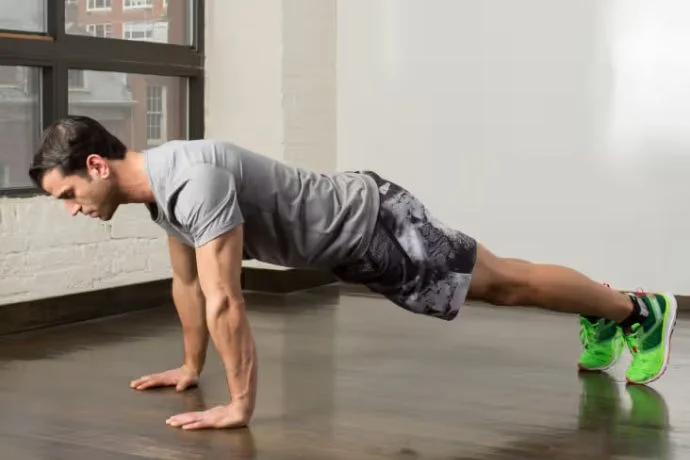
Your 12-Week Full-Body Transformation Plan
This is a 12-week strategy that will help you get from beginner to intermediate level:
Weeks 1-3: Foundation Phase
Goal: Make a habit of doing fundamental motions and get good at them.
Three times a week for 20 to 25 minutes each time
Focus: Keeping the right form and doing it consistently
Weeks 4-6: Building Phase
Goal: Add additional workouts and make the volume higher
How often: 3–4 times a week How long: 25–30 minutes each time
Focus: Progressive overload by doing more reps and sets
Weeks 7-9: Strength Phase
Goal: Get really strong and last a long time
Four times a week, each session lasts 30 to 35 minutes.
Focus: harder variants and more intensity
Weeks 10-12: Integration Phase
Goal: Put everything together for full fitness
How often: 4–5 times a week How long: 30–40 minutes each time
Focus: training for specialized sports and complicated moves
Measuring Your Progress
The scale is not the only way to keep track of development. These are some good ways to tell if your full-body workout is working:
Performance Metrics
Strength Indicators:
- Number of push-ups done in a row
- How long to hold a plank
- Ability to do a single-leg squat
- Progression of pull-ups
Endurance Markers:
- How quickly your heart rate goes back to normal after exercise
- Ability to do longer workouts
- Less tiredness during daily tasks
Body Composition Changes
Measurements to Track:
- Around the waist
- Pictures of progress from different viewpoints
- How clothes fit
- How much energy do you have all day
Quality of Life Improvements
Health Markers:
- How long and how well you sleep
- Ability to handle stress
- Mood and mental clarity
- How sure are you
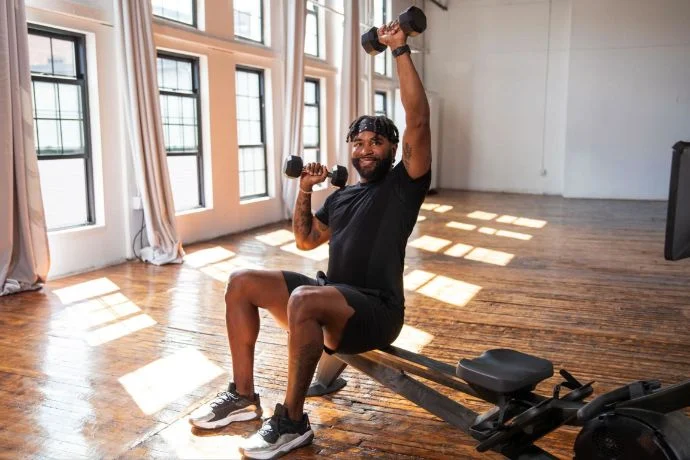
Ready to Start Your Full-Body Workout Journey?
Three months ago, I was coming up with reasons why I couldn’t work out at home. I can’t picture my life without my full-body training routine right now. The change didn’t happen all at once, but it did start with one choice: to start.
You now have everything you need to make a good exercise plan for home. You don’t need to spend a lot of money on equipment, join a gym, or have a lot of spare time. You only need to be willing to start and keep going.
Don’t forget that your next workout is the most crucial one. Every fitness success story began with someone who felt the same way you do now: maybe a little unsure, maybe scared, but ready for something good to happen.
Here’s your action plan to start your full-body workout routine today:
- Make your space clear: Find a 6×6-foot space in your house to work out in.
- Plan out your first three workouts: Pick certain days and times this week
- Start with Workout A: Do the starter regimen I gave you above.
- Keep track of your first session: Write down what you did and how you felt.
- Be consistent: Tell yourself you’ll work out at least twice this week.
The first step on your journey to total body fitness is to do one rep, one workout, and make one choice to put your health first. The hardest thing isn’t the physical difficulty; it’s getting beyond the mental blocks that keep you on the sofa.
Stop putting things off until the perfect time, the proper tools, or the right reason. Today is the day to start, no matter what you have or where you are. Your future self will be grateful that you took that initial step.
Which of today’s exercises will you do first? Now is the time to start your full-body workout transformation!




